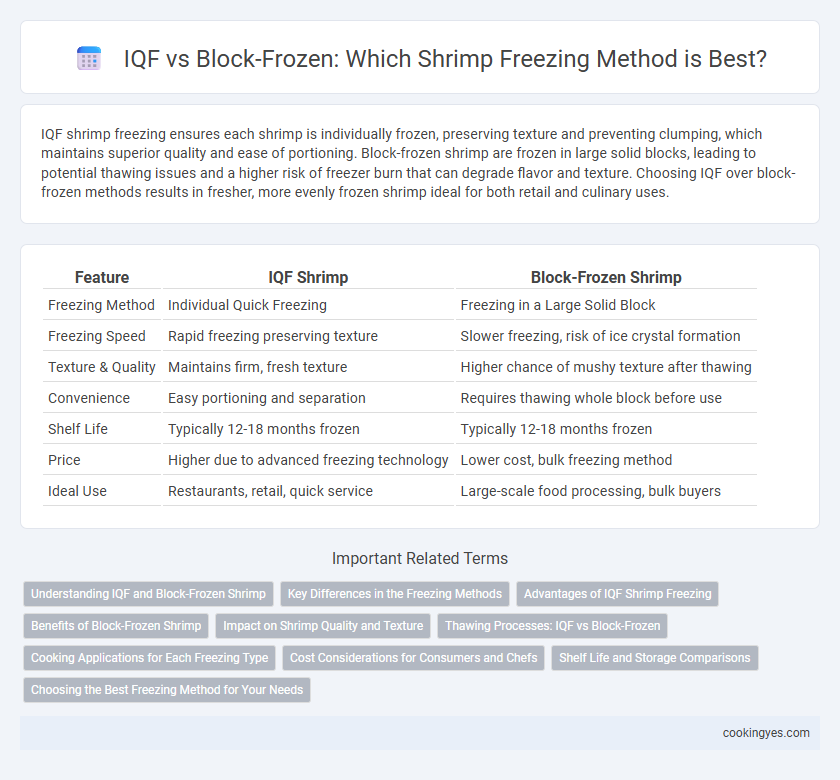IQF shrimp freezing ensures each shrimp is individually frozen, preserving texture and preventing clumping, which maintains superior quality and ease of portioning. Block-frozen shrimp are frozen in large solid blocks, leading to potential thawing issues and a higher risk of freezer burn that can degrade flavor and texture. Choosing IQF over block-frozen methods results in fresher, more evenly frozen shrimp ideal for both retail and culinary uses.
Table of Comparison
| Feature | IQF Shrimp | Block-Frozen Shrimp |
|---|---|---|
| Freezing Method | Individual Quick Freezing | Freezing in a Large Solid Block |
| Freezing Speed | Rapid freezing preserving texture | Slower freezing, risk of ice crystal formation |
| Texture & Quality | Maintains firm, fresh texture | Higher chance of mushy texture after thawing |
| Convenience | Easy portioning and separation | Requires thawing whole block before use |
| Shelf Life | Typically 12-18 months frozen | Typically 12-18 months frozen |
| Price | Higher due to advanced freezing technology | Lower cost, bulk freezing method |
| Ideal Use | Restaurants, retail, quick service | Large-scale food processing, bulk buyers |
Understanding IQF and Block-Frozen Shrimp
IQF (Individually Quick Frozen) shrimp offer superior quality by freezing each shrimp separately, preventing clumping and preserving texture and flavor better than Block-frozen shrimp, which are frozen in large slabs. Block-frozen shrimp often require thawing entire blocks, leading to uneven defrosting and potential quality degradation. The choice between IQF and Block-frozen shrimp impacts shelf life, convenience, and end-product consistency in seafood processing and culinary applications.
Key Differences in the Freezing Methods
IQF (Individually Quick Frozen) shrimp freeze rapidly at extremely low temperatures, preserving their texture, flavor, and preventing large ice crystal formation, which reduces cellular damage. Block-frozen shrimp are frozen in bulk, resulting in slower freezing times that cause larger ice crystals, potentially compromising quality and making thawing slower. IQF offers more convenience for portion control and reduces clumping, while block-frozen shrimp are typically more cost-effective for large-scale processing.
Advantages of IQF Shrimp Freezing
IQF shrimp freezing offers superior advantages by preserving individual shrimp pieces separately, which prevents clumping and makes portion control easier for foodservice and retail use. This method maintains optimal freshness and texture, retaining the shrimp's natural flavor and moisture more effectively than block-frozen shrimp. Enhanced shelf life and quicker thawing times contribute to reduced waste and improved operational efficiency in shrimp processing and distribution.
Benefits of Block-Frozen Shrimp
Block-frozen shrimp maintain superior texture and moisture by freezing large quantities uniformly, reducing individual shrimp exposure to air and freezer burn. This method preserves freshness longer, making it ideal for bulk storage and transportation. Block-frozen shrimp also simplify portion control and reduce packaging waste compared to IQF (Individually Quick Frozen) shrimp.
Impact on Shrimp Quality and Texture
IQF (Individually Quick Frozen) shrimp maintain superior quality and texture by freezing each piece separately, preventing large ice crystals that can damage cell structure and cause mushy texture. Block-frozen shrimp experience slower freezing rates, leading to bigger ice crystal formation that deteriorates flavor, firmness, and overall mouthfeel. Choosing IQF ensures better preservation of shrimp's natural taste and optimal texture compared to block-frozen alternatives.
Thawing Processes: IQF vs Block-Frozen
IQF (Individually Quick Frozen) shrimp thaw rapidly and evenly due to their single-particle freezing, minimizing drip loss and preserving texture. In contrast, block-frozen shrimp require longer thawing times because they are frozen in large slabs, leading to uneven thawing and increased moisture loss. Effective thawing of IQF shrimp enhances product quality by retaining freshness and reducing bacterial growth risks.
Cooking Applications for Each Freezing Type
IQF (Individually Quick Frozen) shrimp retain their shape and texture, making them ideal for stir-fries, salads, and recipes requiring precise portion control or quick thawing. Block-frozen shrimp, typically frozen in large blocks, are better suited for cooking applications where portion flexibility is less critical, such as stews or soups, as they require thawing before use. The choice between IQF and block-frozen shrimp directly impacts cooking time, texture preservation, and ease of handling in various culinary contexts.
Cost Considerations for Consumers and Chefs
IQF (Individually Quick Frozen) shrimp often incur higher initial costs due to advanced freezing technology and packaging, but they provide superior portion control and reduced waste for both consumers and chefs. Block-frozen shrimp generally offer lower upfront prices, making them attractive for bulk purchases, though they may require more handling and result in greater thawing loss. Choosing between IQF and block-frozen depends on budgeting priorities, with IQF favoring convenience and quality preservation, while block-frozen emphasizes cost efficiency.
Shelf Life and Storage Comparisons
Individually Quick Frozen (IQF) shrimp maintain superior shelf life and storage quality compared to block-frozen shrimp due to rapid freezing that prevents large ice crystal formation, preserving texture and freshness. IQF shrimp can be stored for up to 12 months at -18degC without significant quality loss, while block-frozen shrimp typically exhibit shorter shelf life and increased risk of freezer burn from prolonged cold storage. Efficient airflow and minimal clumping in IQF products optimize cold storage space and maintain consistent quality throughout distribution and retail.
Choosing the Best Freezing Method for Your Needs
IQF (Individually Quick Frozen) shrimp maintain superior texture and freshness by freezing each piece separately, preventing clumping and preserving quality during thawing. Block-frozen shrimp are stored in solid blocks, offering cost efficiency and ease of transport but often resulting in longer thawing times and potential texture degradation. Selecting between IQF and block-frozen shrimp depends on factors such as desired convenience, budget constraints, and intended culinary use.
IQF vs Block-frozen for shrimp freezing Infographic

 cookingyes.com
cookingyes.com